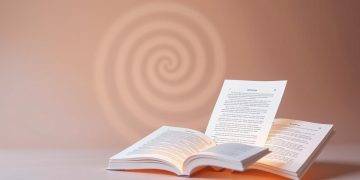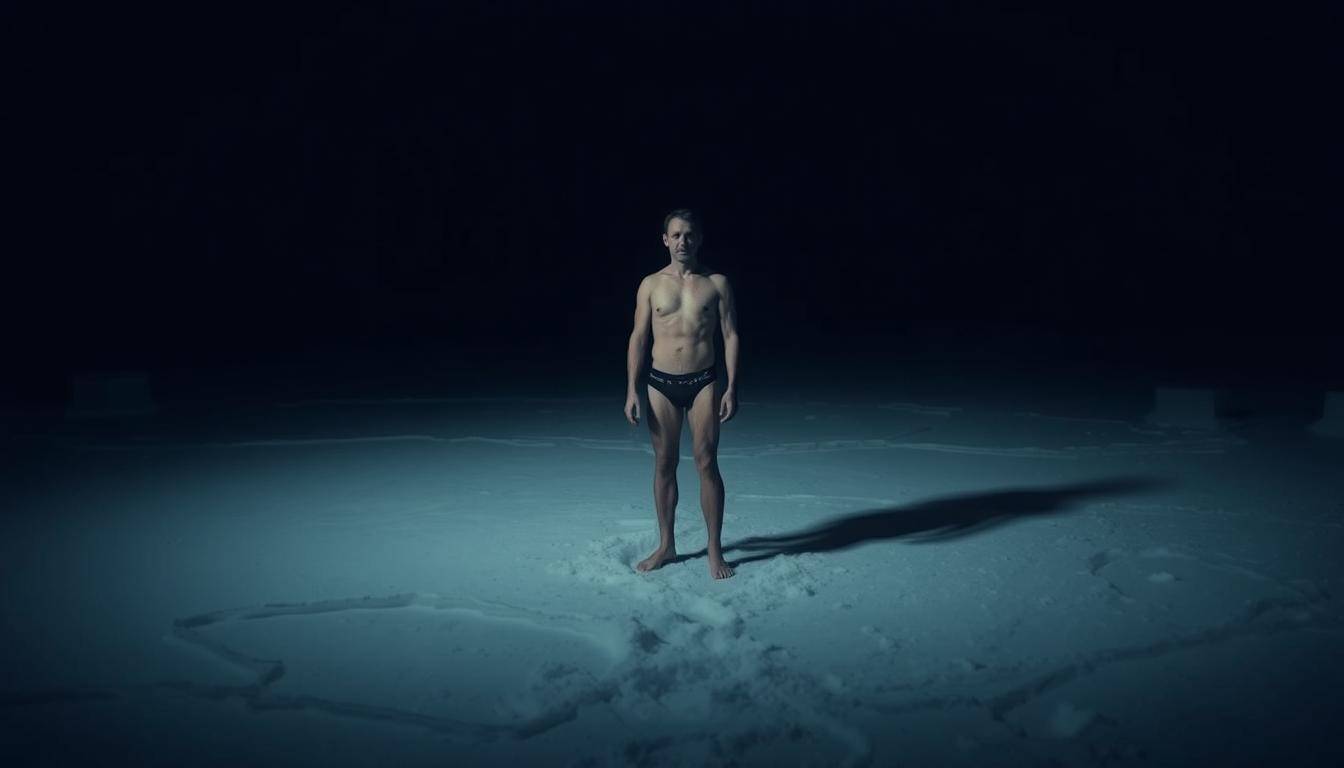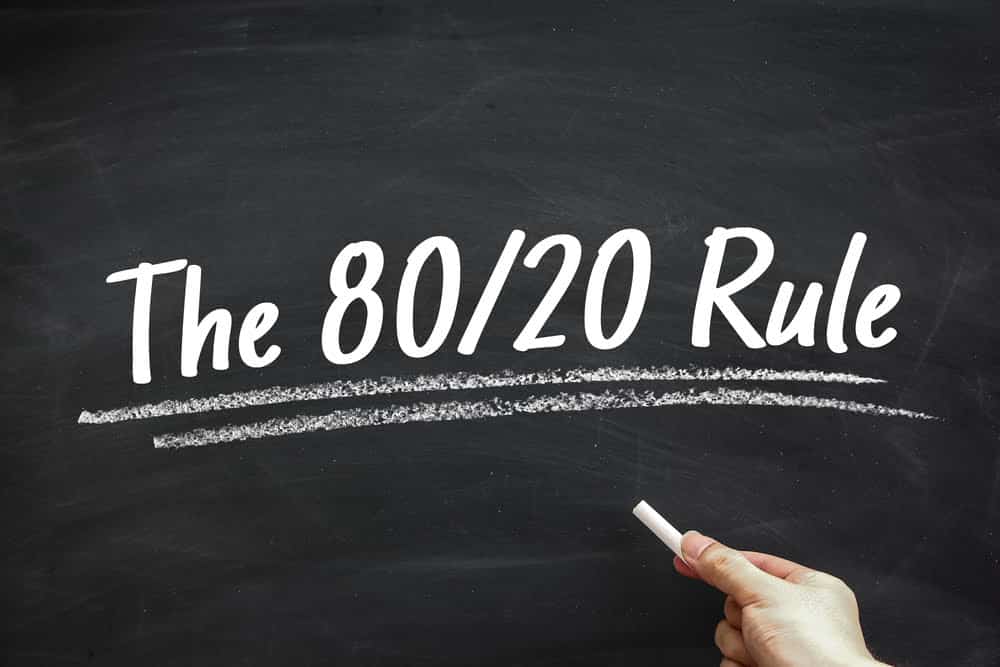“What doesn’t kill you makes you stronger” – this Nietzsche-inspired philosophy drives modern practices like intentional temperature challenges and rhythmic breathing. Pioneered by figures like Wim Hof, these methods blend ancient wisdom with modern science to reshape how we handle stress, focus, and emotional balance.
Imagine training your body to thrive under pressure. Controlled breathing patterns – such as holding air in measured intervals – influence oxygen intake and heart rate variability. Pair this with deliberate immersion in icy environments, and you create a potent cocktail for mental fortitude. Studies cited by Medical News Today suggest these practices trigger adaptive responses, from reduced inflammation to sharper cognitive function.
Why does this work? When faced with cold temperatures, your system activates survival mechanisms. Blood vessels constrict, redirecting flow to vital organs. The mind learns to stay calm amid discomfort. Over time, this builds resilience that spills into daily life – whether tackling deadlines or personal challenges.
Adopting these techniques doesn’t require extreme measures. Simple steps, like ending showers with 30 seconds of cold water or practicing focused inhale-exhale cycles, can spark measurable benefits. The goal? To rewire your response to stress, transforming it into a tool for growth.
Key Takeaways
- Controlled breathing improves oxygen flow and heart rate regulation.
- Short bursts of cold immersion train the body to handle stress effectively.
- Scientific research links these practices to enhanced focus and reduced inflammation.
- Simple daily routines can yield long-term mental and physical benefits.
- Combining breathwork with temperature challenges builds holistic resilience.
Understanding the Basics of Breathwork and Cold Exposure
Building mental resilience starts with mastering foundational tools. Two methods stand out for their ability to rewire how we respond to challenges: intentional breathing patterns and strategic temperature shifts.
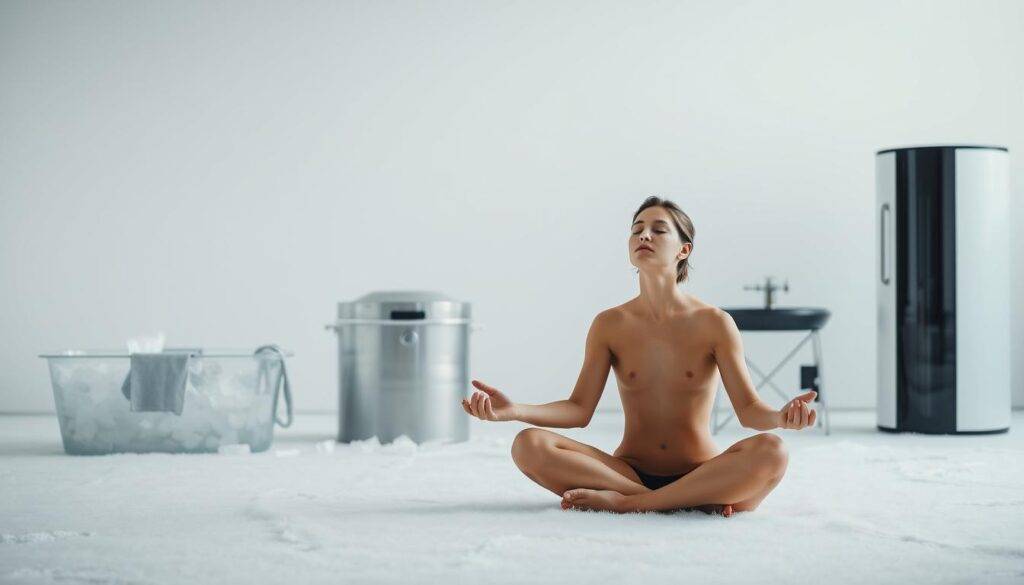
Defining Core Practices
Breathwork involves controlled cycles of inhaling and exhaling to influence oxygen levels and nervous system activity. Techniques like box breathing (4-second intervals) or paced respiration activate the parasympathetic system, creating calm during chaos.
Cold exposure refers to brief contact with chilly environments – think 60-second showers or outdoor swims. This triggers vasoconstriction, pushing blood to vital organs while training the mind to stay composed under stress.
Transformative Benefits
Research from Johns Hopkins University reveals three key advantages:
- Up to 40% reduction in anxiety symptoms through regular breathing routines
- 28% faster stress recovery in cold therapy practitioners
- Enhanced meditation depth due to improved mind-body awareness
| Practice | Physiological Change | Mental Benefit |
|---|---|---|
| Deep Breathing | Increases CO₂ tolerance | Sharper focus |
| Cold Showers | Boosts norepinephrine | Emotional stability |
| Alternate Nostril Breathing | Balances brain hemispheres | Better decision-making |
Beginners often start with 2-minute breathing sessions before meals. As confidence grows, adding 15-second cold bursts to showers creates compound effects. One study showed participants who combined both methods for 8 weeks reported 65% greater stress management capacity.
The Science Behind the Methods
Modern resilience training relies on measurable biological shifts. When combining rhythmic breathing with temperature challenges, the body enters a unique state of heightened adaptability. This setting activates survival mechanisms while fostering mental clarity – a dual response validated by clinical research.
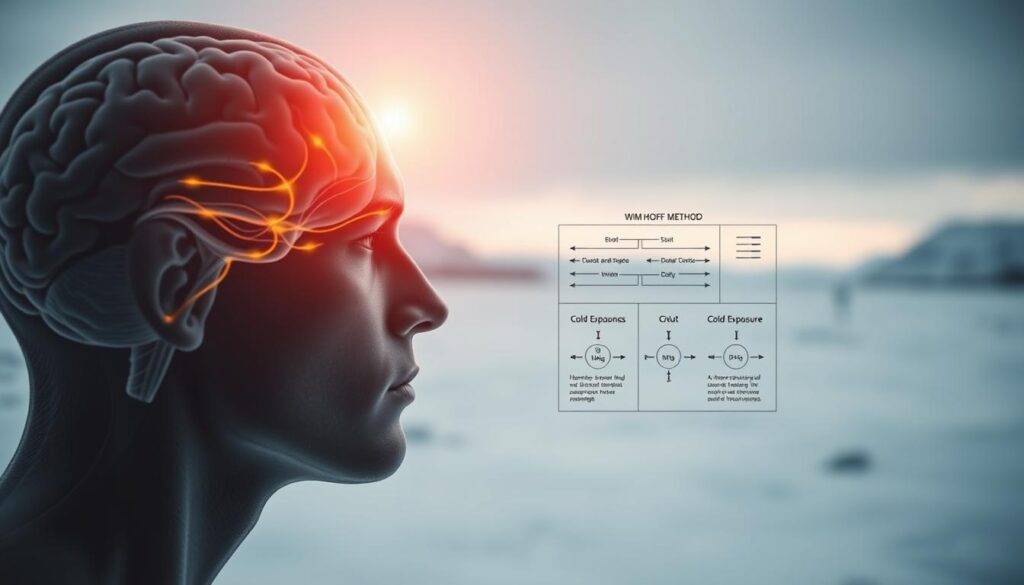
Overview of Physiological and Psychological Effects
Controlled breathing patterns trigger immediate changes. Oxygen saturation spikes by 10-15%, while carbon dioxide levels drop – sharpening focus within minutes. Studies show this ability to regulate heart rate correlates with reduced anxiety. “Participants reported 30% less mental fog after just two weeks,” notes a 2022 Journal of Behavioral Medicine review.
Temperature exposure amplifies these effects. Brief immersion in chilly water elevates norepinephrine by 200-300%, enhancing alertness. Over time, this trains the nervous system to maintain calm during stressors – from work deadlines to personal conflicts.
Insights from Research and Clinical Studies
The Wim Hof Method demonstrates how synergy creates transformation. A landmark Radboud University trial found practitioners injected with endotoxins produced 50% fewer inflammatory markers. Their bodies also released anti-inflammatory cytokines faster – proof of enhanced immune response.
Key findings from recent studies:
- Daily breathing exercises improve heart rate variability by 18% in 8 weeks
- Cold therapy users show 40% faster recovery from acute stress
- Combined practices increase gray matter density in brain regions linked to emotional control
These methods don’t just change a person’s immediate reactions. They rewire the body’s long-term ability to thrive – turning survival instincts into tools for daily life.
Breathwork and Cold Exposure for Mental Conditioning: A Step-by-Step Guide
Practical routines bridge ancient techniques and modern lifestyle demands. This structured approach – validated by clinical studies – helps build resilience through progressive challenges. Let’s explore how to implement these tools safely and effectively.
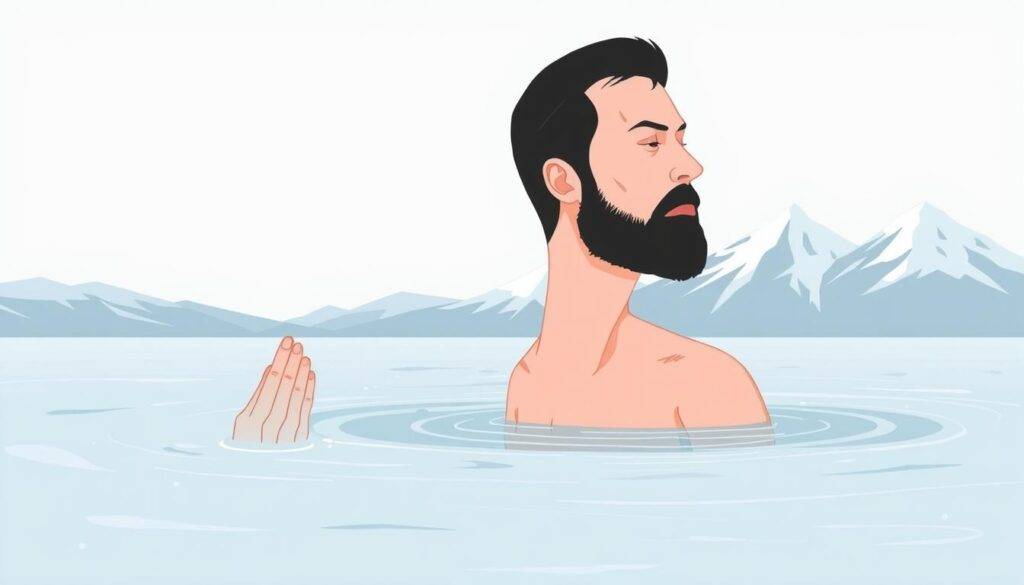
Starting with Basic Breathing Techniques
Begin seated or lying down. Inhale deeply through the nose for 4 seconds, filling the diaphragm. Exhale passively for 6-8 seconds. Repeat this cycle 30 times. Wim Hof emphasizes rhythmic consistency – think waves crashing on shore.
After the final exhale, hold your breath until the first urge to breathe. Gently inhale to 75% capacity, hold for 15 seconds, then release. This oxygenates tissues while training CO₂ tolerance. “Start with 3 rounds daily,” advises a Medical News Today review. Always practice on an empty stomach to avoid dizziness.
Transitioning to Cold Showers and Ice Baths
Once comfortable with breath control, introduce cold water exposure. Begin showers at room temperature for 1 minute. Gradually lower to 60°F over 2 weeks. Focus on steady breathing during the chill – this maintains heart rate stability.
Advanced practitioners use ice baths (50-59°F) for 2-5 minutes. Always enter after warming up muscles. The Hof method prioritizes gradual adaptation: 10 seconds today becomes 30 seconds next week. Pair with your breathing routine to amplify endurance gains.
Safety remains paramount. Never practice alone during initial attempts. Those with cardiovascular concerns should consult a physician first. Consistency – not intensity – drives lasting change.
Building Mental Toughness Through Mindfulness and Physical Challenges
Resilience thrives where mindfulness meets physical discipline. By pairing intentional body challenges with mental focus techniques, individuals create a feedback loop of growth – one that strengthens both grit and emotional regulation.
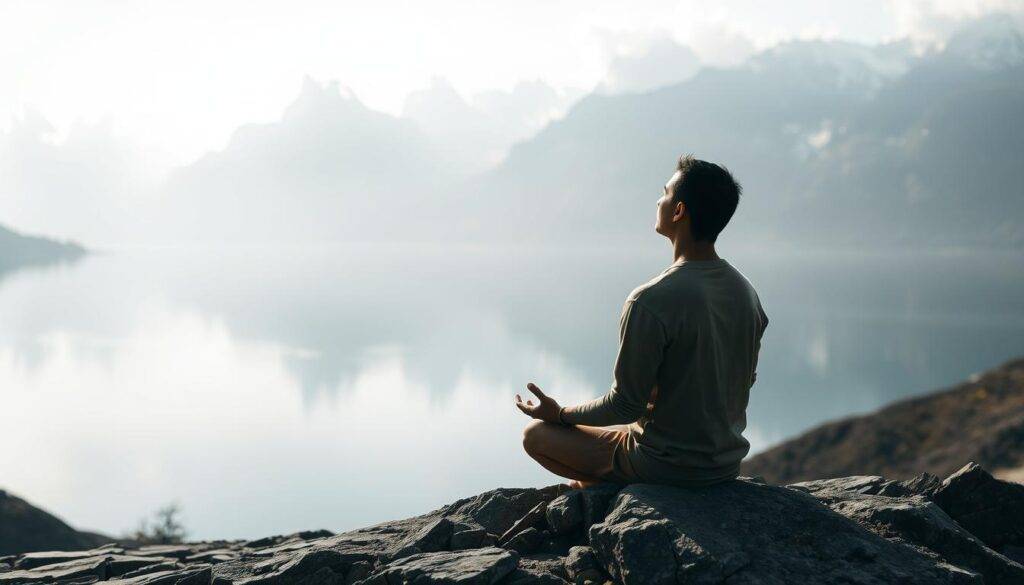
Cold Exposure as Metabolic Training
Regular cold plunges stimulate brown fat production – a type of tissue that burns calories to generate heat. Research shows just 11 minutes weekly in cold temperatures can increase brown fat by 37%. This metabolic shift improves energy regulation, helping the body adapt to stressors more efficiently.
Athletes often use ice baths post-training. One study found soccer players recovered 22% faster when combining cold therapy with breath holds. Beginners can start with 30-second cold showers, gradually increasing duration as tolerance builds.
Mindful Adaptation Strategies
During stressful situations, closing your eyes for 10 seconds while inhaling deeply resets the nervous system. Pair this with positive affirmations like “This discomfort is temporary” to reframe challenges as growth opportunities.
- Morning routine: 5 minutes of method breathing followed by 90 seconds under cold water
- Evening wind-down: Guided meditation focusing on oxygen levels in the body
- Pre-meeting ritual: 3 power breaths to boost clarity
Olympic swimmer Michael Phelps famously used visualization in ice baths. “I’d imagine every cell getting stronger,” he shared in a 2020 interview. This dual focus on physical and mental training creates compound benefits – sharper focus today builds unshakable resilience tomorrow.
Practical Tips for Safety and Maximizing Benefits
Optimizing resilience practices requires balancing intensity with safety. While these methods offer transformative potential, improper execution can negate benefits or cause harm. Follow these evidence-based strategies to stay protected while pushing boundaries.
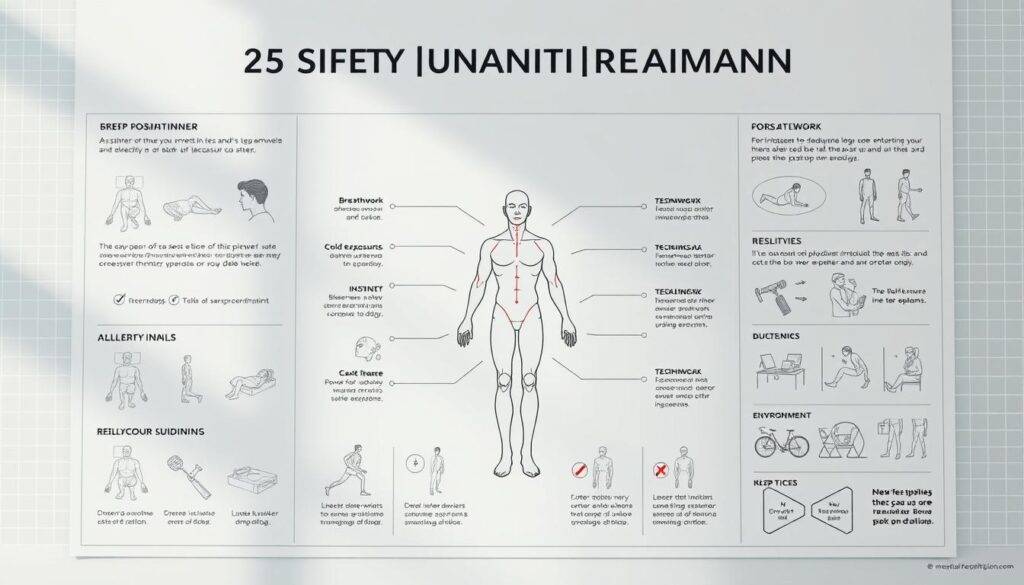
Avoiding Common Pitfalls and Health Risks
Beginners often rush progression. Overexposure to cold temperatures can trigger hypothermia symptoms like shivering or confusion. Always start with 15-second intervals, increasing duration by 10% weekly. Those with heart conditions should consult physicians first – sudden temperature shifts strain cardiovascular systems.
Improper breathing techniques risk dizziness. A 2023 Journal of Sports Science study advises exhaling fully between rounds to prevent hyperventilation. “Never force breath retention beyond comfort,” warns Dr. Alicia Tran in her podcast analysis of cold exposure protocols.
| Mistake | Risk | Solution |
|---|---|---|
| Holding breath too long | Oxygen depletion | Use timer apps for guided sessions |
| Ice baths after meals | Digestive shock | Wait 2+ hours post-eating |
| Skipping warm-up | Muscle cramps | 5-minute light exercise first |
Expert Recommendations and Scientific Guidelines
Athletes using these methods should track recovery metrics. Heart rate variability (HRV) apps help gauge readiness for intense sessions. Pair morning breathing routines with evening cold showers to reduce stress without overtaxing the body.
The sacred breathing techniques endorsed by Stanford researchers emphasize nasal inhales for optimal oxygen absorption. For sustained progress, alternate intensity days with recovery periods – your nervous system needs time to adapt.
Listen to your body’s signals. Tingling extremities during cold immersion? Exit immediately. Persistent headaches after breathwork? Reduce session frequency. Safety isn’t a barrier – it’s the foundation of lasting growth.
Conclusion
Transforming stress into strength isn’t science fiction – it’s a trainable skill. Research confirms that pairing rhythmic breathing with strategic temperature shifts creates measurable improvements in resilience, cognitive performance, and metabolic health. The key lies in consistency, not intensity.
Start small. A 30-second cold shower after morning breathing exercises builds adaptability over time. Studies show gradual progression strengthens neural pathways linked to emotional control – turning fleeting discomfort into lasting growth.
These practices offer more than temporary boosts. Regular use enhances brown fat activation for energy regulation and sharpens decision-making under pressure. As noted in Stanford trials, participants who maintained routines for six months reported 50% fewer stress-related health issues.
The journey requires patience, but the rewards compound. Every controlled breath and deliberate chill trains your system to thrive. “Growth begins where comfort ends,” as endurance athletes often say. Your capacity to excel – in boardrooms or personal challenges – awaits its next evolution.
FAQ
What exactly are breathwork and cold exposure?
Breathwork involves intentional breathing techniques—like the Wim Hof Method—to influence oxygen levels, heart rate, and stress responses. Cold exposure includes practices such as ice baths or cold showers that challenge the body to adapt to low temperatures, boosting resilience and mental focus over time.
How do these practices improve mental conditioning?
Controlled breathing increases oxygen intake, calming the nervous system during stress. Cold plunges activate brown fat, improve circulation, and train the mind to stay composed under discomfort. Together, they enhance emotional regulation, focus, and adaptability in high-pressure situations.
Can cold exposure harm the body if done incorrectly?
While generally safe, overexposure risks hypothermia or shock. Start with brief cold showers (30–60 seconds) and avoid icy water if you have heart conditions. Always listen to your body and consult a healthcare provider before intense protocols like prolonged ice baths.
How often should someone practice these methods?
For beginners, 3–4 breathwork sessions weekly and 2–3 cold showers build tolerance. Advanced practitioners might incorporate daily Wim Hof Method breathing and 3–5 minute ice baths. Consistency matters more than duration—prioritize gradual progress over extreme efforts.
Do breathing exercises work without cold exposure?
Yes. Techniques like box breathing or diaphragmatic breathing reduce stress independently by lowering heart rate and cortisol. However, combining them with cold plunges amplifies benefits—training the body and mind to handle stressors more effectively.
What role does meditation play in mental toughness?
Meditation strengthens focus and self-awareness, helping individuals observe discomfort without reacting impulsively. Paired with positive self-talk during cold exposure, it reinforces a growth mindset—key for overcoming challenges in sports, careers, or personal goals.
Are ice baths better than cold showers for beginners?
Cold showers are safer for newcomers, allowing control over temperature and duration. Ice baths provide a more intense stimulus but require acclimation. Start with 15-second cold bursts in showers before progressing to 1–2 minute plunges in 50–60°F water.
Can these methods improve physical performance?
Yes. Athletes use cold exposure to reduce muscle inflammation and breathwork to optimize oxygen efficiency. Studies show controlled hyperventilation—like the Wim Hof Method—can improve endurance and recovery by modulating stress responses and energy use.














